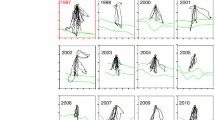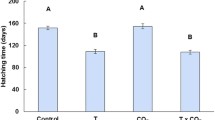Abstract
Climatic variation affects the physical and biological components of ecosystems, and global-climate models predict enhanced sensitivity in polar regions, raising concern for Antarctic animal populations that may show direct responses to changes in sea-ice distribution and extent, or indirect responses to changes in prey distribution and abundance. Here, we show that over a 30-year period in the Ross Sea, average weaning masses of Weddell seals, Leptonychotes weddellii, varied strongly among years and were correlated to large-scale climatic and oceanographic variations. Foraging success of pregnant seals (reflected by weaning mass the following pupping season) increased during summers characterized by reduced sea-ice cover and positive phases of the southern oscillation. These results demonstrate a correlation between environmental variation and an important life history characteristic (weaning mass) of an Antarctic marine mammal. Understanding the mechanisms that link climatic variation and animal life history characteristics will contribute to understanding both population dynamics and global climatic processes. For the world’s most southerly distributed mammal species, the projected trend of increasing global climate change raises concern because increasing sea-ice trends in the Ross Sea sector of Antarctica will likely reduce populations due to reduced access to prey as expressed through declines in body condition and reproductive performance.


Similar content being viewed by others
References
Ainley DJ. 2003. The Ross Sea, Antarctica, where all ecosystem processes still remain for study, but maybe not for long. Mar Ornithol 31:1–16
Ainley DG, Wilson PR, Barton KJ, Ballard G, Nur N, Karl B. 1998. Diet and foraging effort of Adelie penguins in relation to pack-ice conditions in the southern Ross Sea. Polar Biol 20:311–9
Arnbom T, Fedak MA, Boyd IL. 1997. Factors affecting maternal expenditure in southern elephant seals during lactation. Ecology 78:471–83
Arrigo KR, van Dijken GL. 2004. Annual changes in sea-ice, chlorophyll a, and primary production in the Ross Sea, Antarctica. Deep Sea Res II 51:117–38
Arrigo KR, Worthen DL, Schnell A, Lizotte MP. 1998. Primary production in southern ocean waters. J Geophys Res Oceans 103:15587–600
Baker JD, Fowler CW. 1992. Pup weight and survival of northern fur seals Callorhinus ursinus. J Zool (London) 227:231–8
Barbraud C, Weimerskirch H. 2001. Emperor penguins and climate change. Nature 411:183–6
Bowen WD, Ellis SL, Iverson SJ, Boness DJ. 2001. Maternal Effects on Offspring Growth Rate and Weaning Mass in Harbor Seals. Can J Zool 79:1088–101
Bruggeman JE, Garrott RA, Bjornlie DD, White PJ, Watson FGR. 2006. Temporal variability in winter travel patterns of Yellowstone bison: the effects of road grooming. Ecol Appl (in press)
Bureau of Meteorology, Australian Government. 2005. Southern Oscillation Index Archives, 1976 to present. http://www.bom.gov.au/climate/
Burnham KP, Anderson DR. 2002. Model selection and multimodel inference: a practical information-theoretic approach, 2nd edn. Springer Science and Business Media, Inc., New York
Burns JM, Trumble SJ, Castellini MA, Testa JW. 1998. The diet of Weddell seals in McMurdo Sound, Antarctica as determined from scat collections and stable isotope analysis. Polar Biology 19:272–82
Cameron MF, Siniff DB. 2004. Age-specific survival, abundance, and immigration rates of a Weddell seal (Leptonychotes weddellii) population in McMurdo Sound, Antarctica. Can J Zool 82:601–15
Castellini MA, Davis RW, Kooyman GL. 1992. Annual cycles of diving behavior and ecology of the Weddell seal. Bull Scripps Inst Oceanogr 28:1–54
Clutton-Brock TH, Price OF, Albin SD, Jewell PA. 1992. Early development and population fluctuations in Soay Sheep. J Anim Ecol 61:381–96
Comiso JC 1999. updated 2003. Bootstrap sea-ice concentrations for NIMBUS−7 SMMR and DMSP SSM/I, 1978–2003. National Snow and Ice Data Center, Boulder, CO, USA
Craig MP, Ragen TJ. 1999. Body size, survival, and decline of juvenile Hawaiian monk seals, Monachus schauinslandi. Mar Mamm Sci 15:786–809
Crocker DE, Williams JD, Costa DP, Le Boeuf BJ. 2001. Maternal traits and reproductive effort in northern elephant seals. Ecology 82:3541–55
Croxall JP. 1992. Southern ocean environmental changes: effects on seabird, seal and whale populations. Philos Trans R Soc Lond B 338:319–28
Croxall JP, Trathan PN, Murphy EJ. 2002. Environmental change and Antarctic seabird populations. Science 297:1510–4
Domack E, Duran D, Leventer A, Ishman S, Doane S, McCallum S, Amblas D, Ring J, Glibert R, Prentice M. 2005. Stability of the Larsen B ice shelf on the Antarctic Peninsula during the Holocene epoch. Nature 436:681–5
Doran PT, Priscu J, Lyons WB, Walsh JE, Fountain AG, McKnight DM, Moorhead DL, Virginia RA, Wall DH, Clow GD, Fritsen CH, McKay CP, Parsons AN. 2002. Antarctic climate cooling and terrestrial ecosystem response. Nature 415:517–20
Franklin AB, Anderson DR, Gutierrez RJ, Burnham KP. 2000. Climate, habitat quality, and fitness in northern spotted owl populations in northwestern California. Ecol Monogr 70:539–90
Fraser WR, Trivelpiece WZ, Ainley DG, Trivelpiece SG. 1992. Increases in Antarctic penguin populations: reduced competition with whales or a loss of sea-ice due to environmental warming? Polar Biol 11:525–31
Garrott RA, Rotella J, Siniff DB, Hadley GL, Proffitt KM. 2005. An aberrant year in a long-term study of Weddell seal population dynamics: what can be learned from observing extremes? IX SCAR International Biology Symposium, Curitiba, Brazil, pp 25–29
Gille ST. 2002. Warming of the southern ocean since the 1950s. Science 295:1275–77
Hastings KK, Testa JW, Rexstad EA. 1999. Interannual variation in survival of juvenile Weddell seals (Leptonychotes weddellii) from McMurdo Sound, Antarctica: effects of cohort, sex, and age. J Zool London 248:307–23
Hill SE. 1987. Reproductive ecology of Weddell seals (Leptonychotes weddellii) in McMurdo Sound, Antarctica. Ph.D. dissertation. University of Minnesota, St. Paul, MN
Houghton JT, Ding Y, Griggs DJ, Noguer M, van der Linden PJ, Dai X, Maskell K, Johnson CA, Eds. 2001. Climate change 2001: the scientific basis. Cambridge University Press, Cambridge
Hubold G. 1985. Stomach contents of the Antarctic Silverfish Pleuragramma antarcticum from the Southern and Eastern Weddell Sea (Antarctica). Polar Biology 5:43–8
Jenouvrier S, Weimerskirch H, Barbraud C, Park Y-H, Cazelles B. 2005. Evidence of a shift in the cyclicity of Antarctic seabird dynamics linked to climate. Proc R Soc Lond B 272:887–95
Kellogg WM. 1975. Climate feedback mechanisms involving the polar regions. In Weller G, Bowling SA, Eds. Climate of the Arctic. University of Alaska, Fairbanks. pp 111–6
Kwok R, Comiso JC. 2002. Southern ocean climate and sea-ice anomalies associated with the southern oscillation. J Clim 15:487–501
Le Boeuf BJ, Crocker DE. 2005. Ocean climate and seal condition. BMC Biol 3:1743–49
Lefebvre W, Goosse H, Timmermann R, Fichefet T. 2004. Influence of the southern annular mode on the sea-ice–ocean system. J Geophys Res Oceans. 109. DOI 10.1029/2004JC002403
Levitus S, Antonov JI, Boyer TP, Stephens C. 2000. Warming of the world ocean. Science 287:2225–30
Lindstrom J. 1999. Early development and fitness in birds and mammals. Trends Ecol Evol 14:343–8
Loeb V, Siegel V, Holm-Hansen O, Hewitt R, Fraser W, Trivelpiece W, Trivelpiece S. 1997. Effects of sea-ice extent and krill or salp dominance on the Antarctic food web. Nature 387:897–900
McMahon CR, Burton HR. 2005. Climate change and seal survival: evidence for environmentally mediated changes in elephant seal, Mirounga leonina, pup survival. Proc R Soc Lond B 272:923–8
McMahon CR, Burton HR, Bester MN. 2000. Weaning mass and the future survival of juvenile southern elephant seals, Mirounga leonina, at Macquarie Island. Antarct Sci 12:149–53
National Ice Center. 2005. Sea-ice gridded climatology (SIGC) coverage and extent statistics, 1973–1994. [online] URL: http://www.natice.noaa.gov/.
Nicol S, Pauly T, Bindoff NL, Wright S, Thiele D, Hosie GW, Strutton PG, Woehler E. 2000. Ocean circulation off east Antarctica affects ecosystem structure and sea-ice extent. Nature 406:504–7
Oftedal OT, Boness DJ, Tedman RA. 1987. The behavior, physiology, and anatomy of lactation in the Pinnipedia. Curr Mammal 1:175–245
Parkinson CL 2004. Southern ocean sea-ice and its wider linkages: insights revealed from models and observations. Antarct Sci 16:387–400
Sarmiento JL, Gruber N, Brzezinski MA, Dunne JP 2004. High-latitude controls of thermocline nutrients and low latitude biological productivity. Nature 427:56–60
Siniff DB, Demaster DP, Hofman RJ, Eberhardt LL. 1977. An analysis of the dynamics of a Weddell seal population. Ecol Monogr 47:319–35
Smith RC, Ainley D, Baker K, Domack E, Emslie S, Fraser B, Kennett J, Leventer A, Mosley-Thompson E, Stammerjohn S, Vernet M. 1999. Marine ecosystem sensitivity to climate change. Bioscience 49:393–404
Stammerjohn SE, Smith RC. 1997. Opposing southern ocean climate patterns as revealed by trends in regional sea-ice coverage. Clim Change 37:617–39
Stirling I. 1969. Ecology of the Weddell seal in McMurdo Sound, Antarctica. Ecology 50:573–86
Sydeman WJ, Huber HR, Emslie SD, Ribic CA, Nur N. 1991. Age-specific weaning success of northern elephant seals in relation to previous breeding experience. Ecology 72:2204–17
Testa JW, Siniff DB. 1987. Population dynamics of Weddell seals (Leptonychotes weddellii) in McMurdo Sound, Antarctica. Ecol Monogr 57:149–65
Testa JW, Oehlert G, Ainley DJ, Bengston JL, Siniff DB, Laws RM, Rounsevell D. 1991. Temporal variability in Antarctic marine ecosystems: periodic fluctuations in the phocid seals. Can J Fish Aquat Sci 48:631–9
Turner J. 2004. The El-Nino southern oscillation and Antarctica. Int J Climatol 24:1–31
Vaughan DG, Doake CS. 1996. Recent atmospheric warming and retreat of ice shelves on the Antarctic Peninsula. Nature 379:328–31
Vaughan DG, Marshall GJ, Connolley WM, King JC, Mulvaney R. 2001. Devil in detail. Science 293:1777–9
Vaughan DG, Marshall GJ, Connolley WM, Parkinson CL, Mulvaney R, Hodgson DA, King JC, Pudsey CJ, Turner J. 2003. Recent rapid regional climate warming on the Antarctic Peninsula. Clim Change 60:243–74
Vergani DF, Stanganelli ZB, Bilenca D 2001. Weaning mass variation of southern elephant seals at King George Island and its possible relationship with “El Nino” and “La Nina” events. Antarct Sci 13:37–40
Walther G-R, Post E, Convey P, Menzel A, Parmesan C, Beebee TJC, Fromentin J-M, Hoegh-Guldberg O, Bairlein F 2002. Ecological responses to recent climate change. Nature 416:389–95
Weimerskirch H, Inchausti P, Guinet C, Barbraud C 2003. Trends in bird and seal populations as indicators of a system shift in the southern ocean. Antarct Sci 15:249–56
Zwally HJ, Comiso JC, Parkinson CL, Cavalieri DJ, Gloerson P. 2002. Variability of Antarctic sea-ice 1979–1998. J Geophys Res Oceans 107:9–1
Acknowledgments
Funding for this project was provided by a National Science Foundation grant, OPP−0225110. The data were collected under various National Science Foundation grants to R. A. Garrott and J. J. Rotella at Montana State University, D. B. Siniff at the University of Minnesota, M.A. Castellini at the University of Alaska, Fairbanks, and J. W. Testa at the University of Alaska, Fairbanks. We thank all the personnel who participated in the long-term Weddell seal demography study since 1969. We also thank Doug DeMaster and two anonymous reviewers for their insightful comments on an earlier version of this paper.
Author information
Authors and Affiliations
Corresponding author
Rights and permissions
About this article
Cite this article
Proffitt, K.M., Garrott, R.A., Rotella, J.J. et al. Exploring Linkages between Abiotic Oceanographic Processes and a Top-trophic Predator in an Antarctic Ecosystem. Ecosystems 10, 120–127 (2007). https://doi.org/10.1007/s10021-006-9003-x
Received:
Accepted:
Published:
Issue Date:
DOI: https://doi.org/10.1007/s10021-006-9003-x




